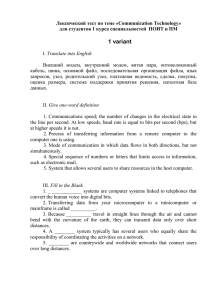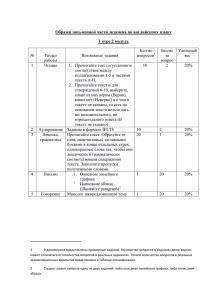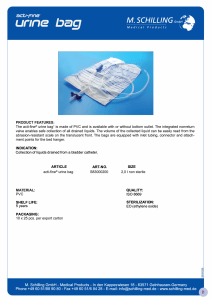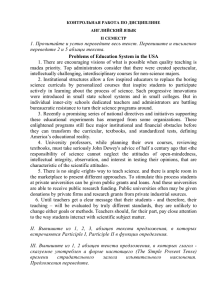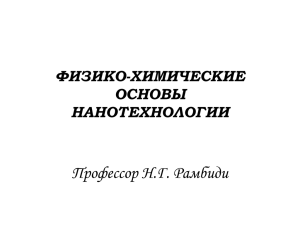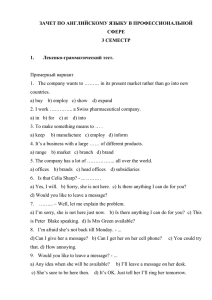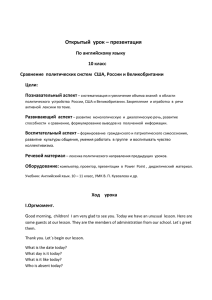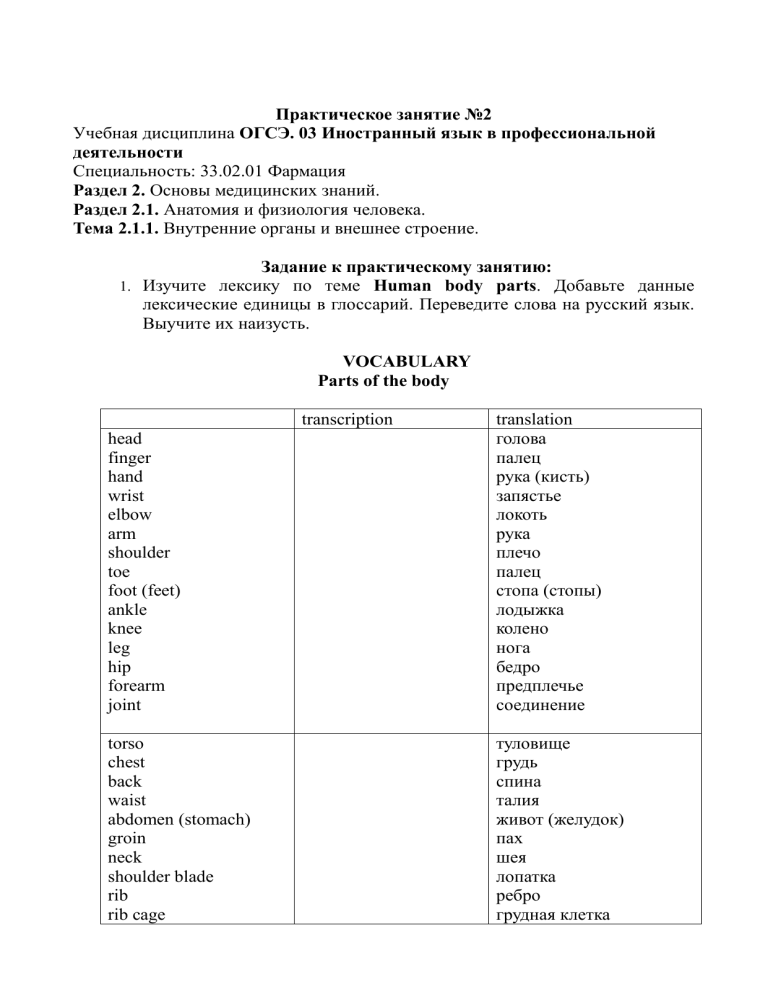
Практическое занятие №2 Учебная дисциплина ОГСЭ. 03 Иностранный язык в профессиональной деятельности Специальность: 33.02.01 Фармация Раздел 2. Основы медицинских знаний. Раздел 2.1. Анатомия и физиология человека. Тема 2.1.1. Внутренние органы и внешнее строение. Задание к практическому занятию: 1. Изучите лексику по теме Human body parts. Добавьте данные лексические единицы в глоссарий. Переведите слова на русский язык. Выучите их наизусть. VOCABULARY Parts of the body transcription head finger hand wrist elbow arm shoulder toe foot (feet) ankle knee leg hip forearm joint translation голова палец рука (кисть) запястье локоть рука плечо палец стопа (стопы) лодыжка колено нога бедро предплечье соединение torso chest back waist abdomen (stomach) groin neck shoulder blade rib rib cage туловище грудь спина талия живот (желудок) пах шея лопатка ребро грудная клетка small bone spine skull pelvis маленький кость позвоночник череп таз face eyes nose lips forehead cheek eyebrow jaw ears chin tongue tooth – teeth mouth hair лицо глаза нос губы лоб щека бровь челюсть уши подбородок язык зуб - зубы рот волосы 2. Подпишите названия частей тела. 1 head 2 neck 1 3 chest 4 abdomen 2 3 4 7 6 8 9 10 5 5 groin 6 torso/ rib cage 7 shoulder blade 8 spine 9 waist 10 pelvis 11 leg 12 foot (feet) 13 hip 14 knee 15 ankle 13 11 14 16 toe 15 12 16 1 head 1 2 forehead 2 3 nose bridge 4 ear 15 3 5 hair 4 14 5 13 7 neck 8 mouth 6 7 6 cheek 8 12 9 10 11 9 tongue 10 chin 11 teeth 12 lips 13 nose 14 eye 15 eyebrow 1 skull 2 chest 1 2 3 rib 3 4 spine 4 5 pelvis 5 6 knee 7 7 thigh-bone 6 3. Ознакомьтесь с содержанием текста. Составьте план текста, соотнесите каждый абзац текста с картинкой внизу. Parts of the Body 1. The body is wonderfully made, like a complex, perfect machine. Each part is specially constructed to carry out its own function, and to work as a whole with the other parts. The body has a strong frame work of bones called the skeleton. The skeleton is covered by muscles and other soft tissues, and by skin on the outside. 2. The human body consists of three parts. They are the head, the trunk and the limbs. The main part of the head is called the skull. The forehead, the temples, the cheeks, the cheekbones, the two jaws and the mouth compose the face. The teeth and the tongue are loading in the mouth. One chews food with the teeth and tastes food with the tongue. The lips are the two margins of the mouth. We see with the eyes, breathe and smell with the nose. 3. The trunk consists of the spine, the chest and the pelvic bones. The trunk is divided into two large cavities by diaphragm. The upper cavity of the trunk is called thorax and lower one is called the belly. The lungs and the heart are located above the diaphragms in the upper cavity. In the lower cavity we find interior organs such as stomach, liver, urinary bladder, gallbladder kidneys, spleen and intestines. 4. The upper limb is divided into the shoulder, the upper arm, the forearm and the hand. The join between upper arm and forearm we call the elbow. The wrist is the joint between forearm and hand. Each hand has five fingers: index, middle finger, ring finger, little finger and a thumb. 5. The lower limb consists of the thigh-bone, the shin-bone and the fibula. We call the calf the back of the lower leg. The join between the femur and the lower leg is called the15knee-joint. This joint is protected by the knee-cap. The joints between lower legs and feet are the ankles. The foot consists of heel, sole and toes. Plan: 1. The skeleton. 2. The skull. 3. The trunk. 4. The upper limb. 5. The lower limb. 2 4 3 1 5 4. Выполните контрольные упражнения: А) Переведите существительные и глаголы из текста на РЯ. a) muscle - мышца, tissue - ткань, skin - кожа, trunk - туловище, limb - конечность, spine - позвоночник, chest - грудная клетка, pelvic - таз, cavity - полость, stomach - желудок, liver - печень, urinary bladder - мочевой пузырь, gall bladder - желчный пузырь, kidney - почка, spleen - селезенка, intestine - кишечник, calf - икра, heel пятка, sole – подошва. b) consist of - состоять из, cover - покрывать, chew - жевать, taste - пробовать на вкус, breathe - дышать, smell - пахнуть, divide into - разделяться на, protect – защищать. B) Ответьте на вопросы по содержанию текста. 1. What functions are performed by parts of the body? - Each part is specially constructed to carry out its own function, and to work as a whole with the other parts. 2. What parts does the body consist of? - The human body consists of three parts. They are the head, the trunk and the limbs. 3. What is the skeleton covered with? - The skeleton is covered by muscles and other soft tissues, and by skin on the outside. 4. What parts does the head consist of? - The main part of the head is called the skull. The forehead, the temples, the cheeks, the cheekbones, the two jaws and the mouth compose the face. 5. What parts does the trunk consist of? - The trunk consists of the spine, the chest and the pelvic bones. 6. What organs are located in the upper cavity? - The lungs and the heart are located above the diaphragms in the upper cavity. 7. What organs are located in the lower cavity? - In the lower cavity we find interior organs such as stomach, liver, urinary bladder, gallbladder kidneys, spleen and intestines. 8. What parts is the upper limb divided into? - The upper limb is divided into the shoulder, the upper arm, the forearm and the hand. 9. How is each finger of the hand called? - Each hand has five fingers: index, middle finger, ring finger, little finger and a thumb. 10. What does the lower limb consist of? - The lower limb consists of the thigh-bone, the shin-bone and the fibula. C) Запишите названия пальцев руки. 1. thumb 2. forefinger 3. middle finger 4. ring finger 5. little finger 5. Изучите грамматический материал: употребление артиклей в английском языке (стр. 7-15 Грамматика английского языка) Практическое занятие №2 Учебная дисциплина ОГСЭ. 03 Иностранный язык в профессиональной деятельности Специальность: 33.02.01 Фармация Раздел 2. Основы медицинских знаний. Раздел 2.1. Анатомия и физиология человека. Тема 2.1.1. Системы человеческого организма. Задание к практическому занятию: Active Vocabulary 1. Ознакомьтесь с активной лексикой практического занятия. Выучите слова наизусть. digestive system [daɪˈdʒestɪv ˈsɪstəm] – пищеварительная система respiratory system [ˈrespərətɔːri ˈsɪstəm] – дыхательная система urogenital system [ˌjʊərəˈdʒɛnɪtəl ˈsɪstəm] – мочеполовая система vascular [ˈvæskjələr](амер.), [ˈvaskjʊlə](брит.) system – сосудистая система skeletal ['skelitl] – скелетный urinary [ˈjuərɪnərɪ] – мочевой endocrine ['endoukrain] – эндокринный alimentary [ˌælɪˈmentərɪ] – пищеварительный reproductive [ri:prə’dʌktiv] – репродуктивный, половой spinal ['spainəl] – спинной, позвоночный hormone ['hɔ:məun] – гормон be stored [sto:d] – сохраняться, храниться, скапливаться pharynx [ˈfærɪŋks] - глотка Прочитайте и переведите текст. Systems of the body. There are several main systems of the body: the skeletal, the muscular, the nervous, the digestive, the respiratory, the urinary, the endocrine and the reproductive systems. The skeletal system consists of the bones of the body and ligaments and cartilages join them. The chief function of the skeletal system is structural. The muscular system consists of the skeletal muscles and their associated structures. The main function of this system is to move us about. The nervous system consists of the brain and spinal cord, nerves, ganglia and receptors. It is a complex information system with all the necessary means for receiving, processing and communicating information. The circulatory system consists of the heart and blood vessels and the blood which is pumped through the blood vessels by the heart. Its function is mainly that of transportation system: the nutrients, oxygen, special substances which are required by cells are carried by the blood system; and the cellular wastes and sometimes other materials produced by the cells and carried away by the blood stream. The digestive system consists of the alimentary canal and a number of associated glands. The respiratory system consist of the lungs, the air passages leading to them and associated structures. Its main function is to convey oxygen to the lungs, where it can enter the blood stream and to remove carbon dioxide, which escapes from the blood into the lung spaces. The urinary system consists of the kidneys which produce urine by removing nitrogenous and other wastes from the blood: the two ureters, which convey the urine away from the kidneys; the urinary bladder, where the urine is stored until it is discharged; and the uretra through which the urine is discharged. The endocrine system consists of a number of glands throughout the body which produce regulatory substances called hormones. The endocrine system serves to regulate a large number of activities. 2. Выполните контрольные упражнения. Exercises I. Find in the text English equivalents for these words and word combinations: 1. несколько основных систем several main systems; 2. которые их соединяют – which join them; 3. основная функция - The chief function; 4. со всеми необходимыми средствами - with all the necessary means; 5. переноситься кровотоком carried by the blood system; 6. ведущих к ним воздухоносных путей - leading to them air structures; 7. где он поступает в кровоток – where it enters the blood stream; 10. вырабатывают веществарегуляторы - produce regulatory substances; 11. для получения, обработки и передачи информации - for receiving, processing and communicating information.; 12. осуществлять наше движение - to move us about; 13. путем выведения азотосодержащих и других продуктов - by removing nitrogenous and other wastes; 14. которые необходимы клеткам which are required by cells; 8. выводить мочу из почек - to convey 15. где накапливается моча - where the urine is stored. the urine away from the kidneys; 9. до тех пор, пока она не выведена until it is discharged; Answer the following questions: 1. What are the functions of the skeletal and muscular system? - The chief function of the skeletal system is structural. The main function of muscular system is to move us about. 2. What is carried by the blood stream? - Тhe nutrients, oxygen, special substances which are required by cells are carried by the blood system; and the cellular wastes and sometimes other materials produced by the cells and carried away by the blood stream. 3. What is the chief function of the blood? - The chief function of the blood is mainly that of transportation system. 4. What does the nervous system consist of? - The nervous system consists of the brain and spinal cord, nerves, ganglia and receptors. 5. What is the main function of the respiratory system? - Its main function is to convey oxygen to the lungs, where it can enter the blood stream and to remove carbon dioxide, which escapes from the blood into the lung spaces. 6. What does the urinary system consist of? - The urinary system consists of the kidneys, the two ureters, the urinary bladder and the urethra. 7. How do the kidneys produce urine? - The kidneys produce urine by removing nitrogenous and other wastes from the blood. 8. How is the urine discharged from the body? - The urine is discharged from the body through the urethra. III. Complete the sentences using words from the text, translate these sentences: 1) Its main function is to convey oxygen to the lungs, where it can enter the blood stream and to remove carbon dioxide, which escapes from the blood into the lung spaces. (Его основная функция заключается в доставке кислорода в легкие, где он может поступать в кровоток, и удалении углекислого газа, который выходит из крови в легочные пространства.) 2) The digestive system consists of the alimentary canal and a number of associated glands. (Пищеварительная система состоит из пищеварительного канала и ряда связанных с ним желез.) 3) The nervous system is a complex information system with all the necessary means for receiving, processing and communicating information. (Нервная система - это сложная информационная система со всеми необходимыми средствами для получения, обработки и передачи информации.) 4) The endocrine system consists of a number of glands throughout the body which produce regulatory substances called hormones. (Эндокринная система состоит из ряда желез по всему телу, которые вырабатывают регулирующие вещества, называемые гормонами.) 5) There are several main systems of the body: the skeletal, the muscular, the nervous, the digestive, the respiratory, the urinary, the endocrine and the reproductive systems. (Существует несколько основных систем организма: скелетная, мышечная, нервная, пищеварительная, дыхательная, мочевыделительная, эндокринная и репродуктивная системы.) 6) The endocrine system serves to regulate a large number of activities. (Эндокринная система служит для регулирования большого количества видов деятельности.) 3. Изучите грамматический материал: имя числительное в английском языке. (стр. 76-81 Грамматика английского языка)
